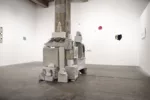The last scene in Andy Warhol — the first documentary made about the artist after he died in February, 1987 — is a close-up of Warhol talking while he’s having make-up applied by an assistant, presumably for a tv appearance although it’s not clear. He’s having a conversation with someone off camera and he’s talking about make-up. Specifically, make-up that’s applied to dead bodies for a funeral. As he talks, Warhol’s image begins to pixillate, growing more and more abstract as he says things like “Death can make you a star but if the make-up isn’t right, it’s all people will talk about.”
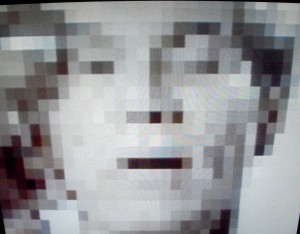
In the movie directed and produced by Kim Evans, which I watched over the weekend (from ArtHaus Musik), Brigid Berlin, one of Warhol’s Factory entourage says Andy thought death was abstract and that people just went away — they were only shopping in Bloomingdales. So to have the artist pixillate his way off the screen talking about funerals and makeup is great. It makes him the abstraction he thought he’d become in death.
Berlin is one of many great talkers in the 77-minute long movie that’s got just enough biography mixed in with clips of the artist, photo montages of his work and a steady stream of interviews of people through the ages who know Warhol and were friends (Emile de Antonio), early dealers (Ivan Karp) and others.
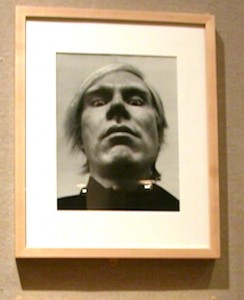
Produced soon after the artist died, the movie skirts some of the seamier aspects of Warhol’s life that have been written about (the hedonistic Studio 54 years, the perhaps less than loving treatment of his mother and family, his stinginess with money) but it doesn’t pull punches when it comes to Warhol’s strengths as an artist. The movie is enthusiastically pro-Warhol’s art, especially the early art — and the late self-portraits. De Antonio, who comes across as the most articulate and thoughtful of the many articulate and thoughtful talkers in the movie, quotes Duchamp on Warhol (to wit, What’s interesting is not the image of the soup cans but the mind that thought up the image). De Antonio says that Warhol was all about “the thingness of things…In a thing-oriented culture Andy was a god. He was deeply religious that way. He gave us what we wanted.”
The movie also has a generous smattering of archival clips of Warhol being interviewed. He was a slippery character and always wearing the mask of the idiot savant. He made the groundbreaking Pop images and then confessed that he didn’t know why he did so or what it all meant except that it looked nice. There’s one interview from the 1960s where he’s standing in a gallery in front of a stack of Brillo Boxes. Ivan Karp is there next to him. Warhol is poker faced as the interviewer asks him “Is pop art becoming repetitious?” And he stays poker faced and answers quietly “Yes.” Karp, surprised by the answer, turns to look at Warhol and they both smile like at some inside joke. Next question, “Are you going to carry on?” Warhol: “Yes.” End of interview. Karp later talks about the gallery debut of the Brillo Boxes and how they didn’t have any idea how to price them — they didn’t expect any to sell. He remembers they settled on $200 or $300 and that they sold two or three.
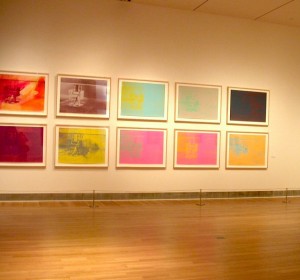
Karp is a lively raconteur and his best story is about how very early on he told Andy to lose the abstract expressionist drip marks and just go with the images.
Andy: But you must drip!
Karp: Why? Just deal with the images.
Andy: Really? That’s wonderful! I don’t think I want to drip.
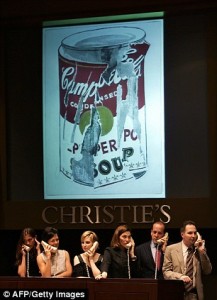
Then there is the great 1966 clip, played widely (it was in Painter’s Painting I believe). Warhol is sitting on a high stool in front of a double Elvis painting and he’s being difficult. He doesn’t want to answer the questions. Rather, he says he’ll say whatever the interviewer tells him to say.
Andy: I wish you’d tell me the words and they’ll come out of my mouth….I think it’d be so nice.
The film deals well with the changes over time to Warhol’s entourage, from the wild and wooly 60s in the Factory with all kinds of weird hangers on, drug use and lots of great experimental art making to the 70s with the commercial portrait paintings that netted him millions of dollars and entree to the rich and famous. And in the 1980s he sought new energy and relevance by collaborating with young artists (Keith Haring, Jean Michel Basquiat). He also had a couple of cable tv shows ( “Andy Warhol’s TV” in 1982 and “15 Minutes” on MTV in 1986 — both on cable tv).
There’s not much commentary on the late work. The most memorable is Robert Rosenblum who says of Warhol’s last London show in 1986 at the Hayward Gallery (all large self-portrait heads) that the show reminded him of the great artists late in life who turned their gaze inward — Rembrandt and Van Gogh. Rosenblum confesses he feels a little self-conscious saying that but his words stick.
Vincent Fremont, who was the Warhol studio manager at the time of the artist’s death, says in this movie what most people feel today — that Warhol will be bigger in death than he was in life, by virtue of his art and the Warhol Foundation, which gives millions of dollars to artists and institutions for creative projects that might not be fundable elsewhere.
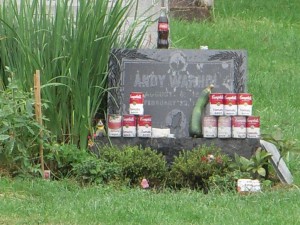
One thing is sure. Warhol’s art is ubiquitous in museums around the world and he’s one of the most loved and respected artists, by art insiders and others. Two shows of Warhol’s late works are around this summer. Check them out at Pafa and the Brooklyn Museum.
Andy Warhol, 1987, documentary directed by Kim Evans, available on DVD from Art Haus/Musik via Amazon
Andy Warhol Polaroids and Black&White Photographs, to Sept. 12. Pennsylvania Academy of the Fine Arts, Samuel M. V. Hamilton Building 128 N. Broad Street Philadelphia, PA 19102 215-972-7600
Andy Warhol the Last Decade, to Sept. 12. Brooklyn Museum, 200 Eastern Parkway, Brooklyn (718) 638-5000





